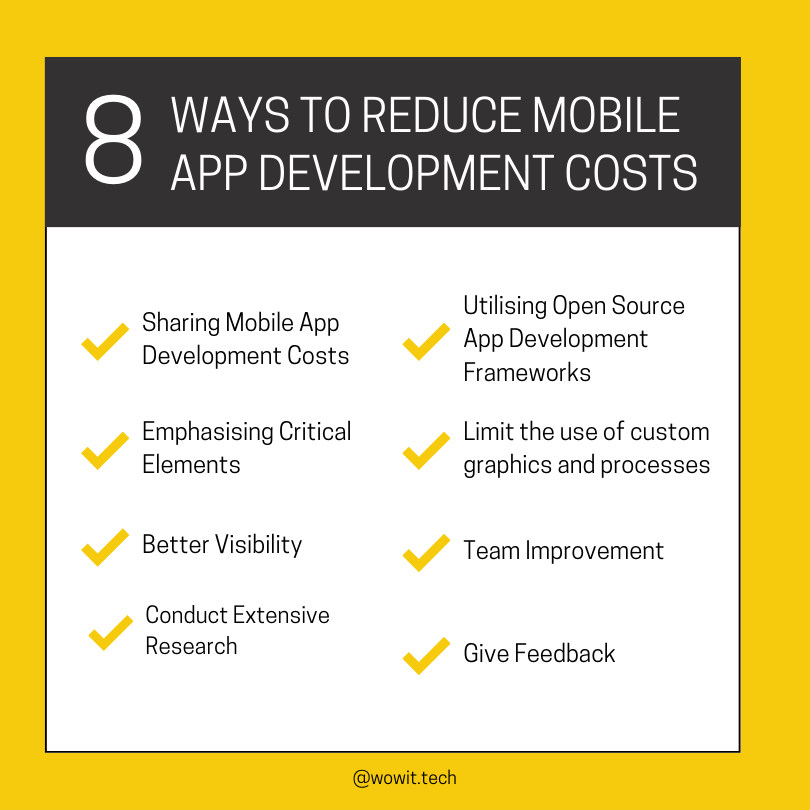To reduce mobile app development costs, there are several strategies you can consider. Reducing mobile app development costs is a common concern for businesses due to budget constraints and the need to maximize return on investment. There are several strategies that can help achieve this goal. Firstly, businesses can opt for cross-platform development frameworks like React Native or Flutter, which allow developers to write code once and deploy it on multiple platforms, saving time and effort. Additionally, using pre-built templates or UI kits can reduce design and development costs. Outsourcing development to countries with lower labor costs can also be a cost-effective option. Lastly, prioritizing essential features and functionalities during the development process can help minimize unnecessary expenses. Overall, businesses should carefully evaluate their requirements and explore cost-saving measures to achieve their mobile app development goals within budget.

How to reduce mobile app development costs without sacrificing quality?
The cost of developing an app might be high, especially if you do not know how to accomplish it cheaply and effectively. What you must do to keep expenses low and quality high is as follows:
1. Sharing Mobile App Development Costs
To reduce mobile app development costs, both the company and developers can explore options for cost-sharing. One approach is for the developer to seek funding from an investor in exchange for a share of the app’s potential earnings. Alternatively, a corporation with a limited budget may choose to fund the developer and acquire complete rights to the app, ensuring the project’s completion. This way, both parties can find a mutually beneficial arrangement to manage costs and achieve their goals.
2. Emphasising Critical Elements
When developing a mobile app, it’s important to consider that you don’t have to include every possible feature for users. Instead, focus on the specific services and value you want to offer. Including too many features can confuse customers and make the app difficult to use. It can also increase development time and costs, which is crucial if profitability is uncertain. By prioritizing essential features and avoiding unnecessary complexities, you can streamline development, minimize costs, and create a more user-friendly app that meets the specific needs of your target audience.
3. Better Visibility
App translation is a terrific technique to improve installs because Google Play favors localized apps for a better user experience. A higher ranking in the software Store means that your software will be more visible to its visitors.
Identifying your target demographic is a critical step in developing your brand. To appeal to this audience, you must first learn their likes and dislikes, communication preferences, and so on. Some apps make determining the target audience easier than Better Branding.
Identifying your target demographic is a critical step in developing your brand. To appeal to this audience, you must first learn their likes and dislikes, communication preferences, and so on. Some apps make determining the target audience easier than others.
4. Conduct Extensive Research
Conducting thorough research on similar apps in the market, user demands, and criteria can save you significant time and help you avoid common mistakes. By undertaking an in-depth study of existing applications, you can gain valuable insights and come closer to creating your desired product. This research will also enable you to streamline your development process, making it more efficient and cost-effective. By understanding what works and what doesn’t in existing apps, you can make informed decisions and allocate resources more effectively, ultimately reducing expenses and accelerating the organization of your project.
5. Utilising Open Source App Development Frameworks
Learn about the free cross-platform app development frameworks that might help you reduce your budget margin. If you check out the freely available cross-platform app development frameworks, you can effectively reduce the cost of mobile app development by a large percentage
All you have to do is search online for several such services and determine which one is best for your job. A company that develops Android applications should seek frameworks that help reduce development costs.
6. Limit the use of custom graphics and processes
Though most mobile apps are fairly diverse, they all share characteristics such as buttons, navigation type, and other aspects. It occurs as a result of general users’ expectations of the mobile app to operate in a specific manner. For example, Apple has established Human Interface Guidelines that must be followed by all iOS apps to be approved and published on the App Store.
As a result, utilizing pre-created buttons and related features can undoubtedly save valuable time and money. However, you must customize the program, but draw a narrow line whenever personalization is unnecessary.
7. Team Improvement
Dividing app development tasks among team members based on their skills can help control mobile app development expenses. By assigning tasks judiciously, you can ensure that each person is working on areas where they excel, maximizing efficiency and productivity. Additionally, since many apps have similar elements like navigation or buttons, utilizing pre-built options can save time and resources. Instead of reinventing the wheel, leverage existing solutions or frameworks that are readily available. This approach can reduce development costs by avoiding unnecessary duplication of efforts and taking advantage of proven solutions. However, it’s important to strike a balance and customize where necessary to meet the specific requirements and unique aspects of your app.
8. Give Feedback
Distributing the responsibility of application development within your team requires careful consideration. Start by assigning tasks to the most senior members and gradually delegate to more junior members. This approach ensures that experienced developers handle critical aspects of the project while providing learning opportunities for others.
Since developers’ time is valuable, it’s important to closely monitor their work and provide regular feedback. This helps them understand what is correct and what needs improvement. Regular feedback sessions can help address any issues or challenges early on, ensuring that the development process stays on track and aligns with the desired outcomes.
By distributing responsibilities wisely and providing constructive feedback, you can optimize the productivity and efficiency of your development team, ultimately leading to better results while managing costs effectively.
Conclusion:
By honestly following these criteria, you can reduce the cost of mobile app development. As previously said, a mobile development business may easily reduce the cost of mobile app development. Simply by adhering to these criteria, such as intelligently separating separate tasks, providing feedback, and removing non-essential design aspects and features, you will notice that there is a considerable amount of time and money that can be readily saved by simply planning.
Remember, while cost reduction is important, it’s equally crucial to maintain the quality and performance of your app to ensure user satisfaction and long-term success.
WOWIT an IT service and Digital marketing agency can help you with all your Marketing strategy needs for your brand. Book a call so we can discuss how to create a memorable digital experience for you.


